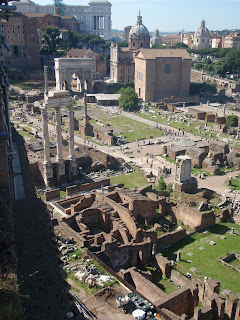The Colosseum and Roman Forums are both historical monuments and major tourist destinations. They both portray the incredible Roman architecture long before modern technology. It is amazing to look at these structures and think about how long they have survived and what they were used for.
The Colosseum is probably one of the most frequented tourist attractions in Rome today. The Colosseum was originally known as the Flavian Amphitheatre. It was not known as the Colosseum until the 7th Century. The Amphitheater was designed to hold 50,000 spectators. It was completed in 80 A.D. It is known to be the first permanent amphitheater built in Rome. The incredible arches involved in the magnificent architecture speak wonders about Roman intellect.
With the eighty entrances the Roman people were able to manage, control, and entertain the large crowds quickly with ease.
Looking at the incredible structure of the Colosseum, that so many people enjoy every day, it is incredible thinking about the actual purpose for which it was built. The Colosseum was built to host gladiatorial games, combats and executions. It also hosted different games with wild beasts verse each other, as well as wild animals verses humans. The Roman’s believed that it was a sacred place because it was a place of martyrdom. Looking at the Colosseum today, it is incredible to think of the number of both humans and animals lives lost. There is no exact number recorded of the deaths in the Colosseum, however they have an estimated amount. During a single festival held in 240 AD the statistics say that there were 2,000 gladiators lost in a matter of a few days. It is strange to think that people enjoyed watching gory deaths such as the murders in the Colosseum. People took pleasure in participating in the rulings of live verses death.
. Gladiatorial combats continued in the Amphitheater until they were outlawed in 407 by the Christian emperor Honorius. The fights wild beats were finally outlawed in 523. The Colosseum went out of use after these bans.
People are still entertained by gory things today, however. Many people are grossed out by the thought of the Colosseum, but do not think twice about watching a gory movie. Movies are not the only gruesome form of entertainment in society today. Video games, such as Mortal Combat or Call of Duty, all include killing people. In many places such as Mexico bull fights are still held. People need to keep an open mind when entering the Colosseum and think past the gore and deaths involved.
Another incredible tourist destination is the Roman Forums. The Roman Forums were the centre of political, judicial and commercial life in Ancient Rome. The centre was also the home of many markets, shops, and taverns. Many people gathered in the Roman Forums as a place for social gatherings and for entertainment. The Forums were the heart and soul of city life. Entertainment was a major part of the Roman Forums. The architecture, although not as elaborate as the Colosseum, was built in Marble. The columns stood high above the ground. The Roman people used elephants to raise the columns to stand erect. To think of the labor and mathematics involved in the creation of the Forums is mind blowing. Many people look at structures such as these and think of their age. Sometimes people do look past the incredible amount of thought and planning to build formations such as these forums and instead look at them as decrepit and old.
People tend to think of buildings such as the Colosseum and the Roman Forums as ancient but do not realize the mathematics and intellect put into designing them. They are misinterpreted. It is mind blowing to actually look at these structures and think about how amazing they actually are. These buildings are absolutely incredible. Today these two destinations are a major route on the Rome tourist hot spots. They both have a entrance charge that helps the Roman community today. The Colosseum raises money to help feed the poor and the hungry. The Colosseum and the Roman Forums were and continue to be a major strength in the Roman community.
-Kathryn Jordan
 Laundry is not as easy as pressing a button. Today I learned the hard way how to wash you clothes the old fashioned way. Let's just say I have a lot more respect for my mom and the invention of the washer machine and dryer, as well as for everyone in my life who ever let me use their laundry facilities!
Laundry is not as easy as pressing a button. Today I learned the hard way how to wash you clothes the old fashioned way. Let's just say I have a lot more respect for my mom and the invention of the washer machine and dryer, as well as for everyone in my life who ever let me use their laundry facilities! 






